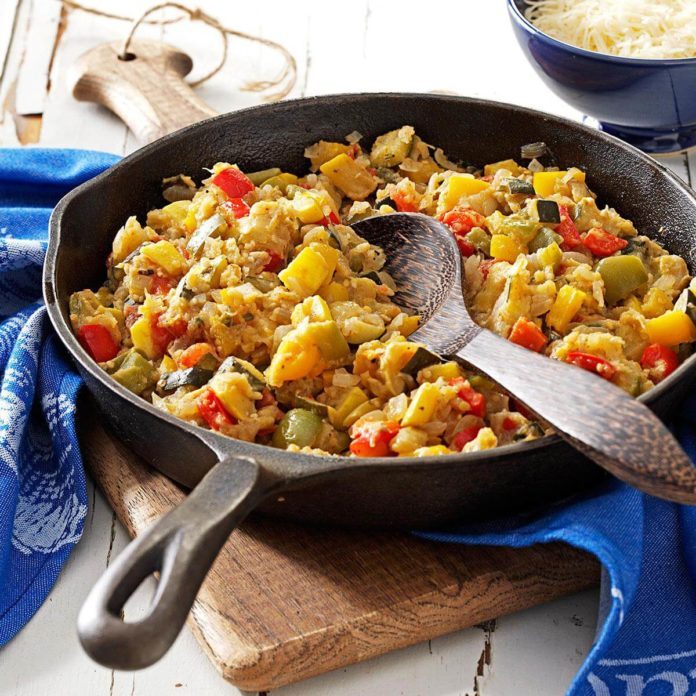Much like their tomato cousins, eggplants are at the center of a very important debate: Are they fruit, or are they vegetables? Though they’re often mistaken as the latter, eggplants are actually berries and part of the nightshade family, which includes tomatoes and potatoes. However, that doesn’t mean you can’t treat them like veggies—they can be made into a spread or mixed with pasta or turned into fries—and their versatility makes them the perfect go-to ingredient.
But there’s more to life than the big purple ones you’re familiar with: Meet the Chinese eggplant.
What is a Chinese eggplant?
Chinese eggplants are long and thin with vibrant lavender skin and white flesh, and can appear either crooked or straight. They taste mildly sweet and hold up when cooked.
What other types of eggplant are there?
When you see the word “eggplant,” that’s usually referring to the large varieties most often found in grocery stores, which are called globes. They’re hefty, have little green caps, and tend to be more bitter, meaty and flavorful.
There are many other varieties of eggplant, too—graffiti, Indian, Japanese and Italian, to name a few. While each is delicious in its own right, unique properties make a certain type best suited for certain dishes.
What’s the difference between eggplant and Chinese eggplant?
Chinese eggplants have fewer seeds than globes, which reduces their bitterness. And they have a thin skin. While they can be substituted for each other, globes may be less sweet, influencing the outcome of the final dish.
How do you pick the best Chinese eggplant?
Picking Chinese eggplant is the art of picking any eggplant. Look for ones that are firm and have shiny skin, and avoid any blemishes or soft spots. This means that they’ll be young, tender and full of flavor.
Do you need to salt Chinese eggplant?
Nope! Because they have fewer seeds, Chinese eggplants are less bitter than globes and do not need to be salted. Salt is used to draw out bitterness, but this variety is naturally sweet. In fact, if an eggplant is picked fresh, it most likely doesn’t need salt, no matter the variety.
How to Cook Chinese Eggplant
What can’t you do with Chinese eggplant? They shine in stir fries, as pickles or braised. Try them in this recipe, from North Carolina reader Allyson Meyler. It calls for conventional eggplant, but the Chinese eggplant’s inherent sweetness will be accentuated by the lime juice and sesame, letting the spices shine. It makes six tasty servings.
Ingredients
- 3 tablespoons lime juice
- 1 tablespoon sesame oil
- 1-1/2 teaspoons reduced-sodium soy sauce
- 1 garlic clove, minced
- 1/2 teaspoon grated fresh ginger root or 1/4 teaspoon ground ginger
- 1/2 teaspoon salt
- 1/8 teaspoon pepper
- 1 medium eggplant (1-1/4 pounds) cut lengthwise into 1/2-inch slices
- 2 teaspoons honey
- 1/8 teaspoon crushed red pepper
- Thinly sliced green onion and sesame seeds
Step 1: Get grillin’
In a small bowl, whisk the first seven ingredients until blended. Then, brush 2 tablespoons of the juice mixture over both sides of the eggplant slices. Grill, covered, over medium heat 4-6 minutes on each side, or until tender.
Step 2: Add a garnish
Transfer eggplant to a serving plate. Stir honey and pepper flakes into the remaining juice mixture and drizzle it over the eggplant. Sprinkle with green onion and sesame seeds.
Need more eggplant in your life? These recipes are a good place to start.
This grilled side goes well with pasta or meats also made on the grill. Thanks to the Cajun seasoning, it gets more attention than an ordinary veggie. —Greg Fontenot, The Woodlands, Texas
Get Recipe
Because my recipe calls for baking the eggplant instead of frying it, unlike most eggplant Parmesan recipes, it’s much healthier! It takes a little extra time, but the Italian flavors and rustic elegance are well worth it. —Laci Hooten, McKinney, Texas
Get Recipe
This rich and flavorful ratatouille is the perfect salute to the harvest. Hearty and full of veggies, it fills the kitchen with the comforting aroma of thyme, onions and garlic. —Diane Trester, Sheboygan, Wisconsin
Get Recipe
Spice-coated chicken thighs simmer in a rich red pepper-eggplant sauce. This savory entree is perfect for an everyday meal or potluck. It's an easy slow-cooker dish to prepare in the morning so that dinner is ready at the end of the day.—Judy Armstrong, Prairieville, Louisiana
Get Recipe
Black pepper and garlic perk up this out-of-the-ordinary spread that hits the spot on a crisp cracker or toasted bread slice. —Barbara McCalley, Allison Park, Pennsylvania.
Get Recipe
We love eggplant Parmesan, but when it’s hot outside, the dish feels too heavy. Grilled eggplant slices topped with tomato, mozzarella and Parm satisfy everyone. —Joann Parlin, Little Egg Harbor, New Jersey
Get Recipe
I first ate this sandwich while vacationing in Sedona, Arizona, and fell in love with it. When I returned home, I developed this one that tastes just like the original. —Carolyn Phenicie, Titusville, Pennsylvania
Get Recipe
I'm now a professional chef, but I loved making this recipe for the family on Friday nights as a home cook. We like to shake pizza up with unique, fresh toppings. —Christine Wendland, Browns Mills, New Jersey
Get Recipe
If you want your kids to happily eat their eggplant, serve it in this lovely layered casserole. Our whole family enjoys it. Always a popular potluck item, it's a great company dish, as well. —Carol Mieske, Red Bluff, California
Get Recipe
We always have a large summer garden where lots of produce lingers into fall. That's when we harvest our onion, bell pepper, tomatoes and eggplant, the main ingredient of this dish. This recipe turns Cajun with the Holy Trinity (onion, celery and bell pepper), shrimp and red pepper flakes. —Barbara Hahn, Park Hills, Missouri
Get Recipe
When I lived in Greece, I fell in love with eggplant. My recipe's seasonings have an Asian theme, but the dish still makes me think Greek. —Allyson Meyler, Greensboro, North Carolina
Get Recipe
Here's a healthy version of a restaurant classic that you can easily make at home. Our recipe has 300 fewer calories and half the fat and sodium of typical eggplant Parmesan. —Taste of Home Test Kitchen
Get Recipe
Grill this eggplant, tomato and goat cheese sandwich to perfection...it makes a delicious meatless meal. —Jennifer Jaras, Corona, California
Get Recipe
My kids love this snack—and I like that it's healthy. Coated with Italian seasoning, Parmesan cheese and garlic salt, these veggie sticks are broiled, not fried, so there's no guilt when you crunch into them. —Mary Murphy, Atwater, California
Get Recipe
Someone at the table is bound to praise your rollatini dish, then ask what the heck it is. Your simple answer: thin slices of eggplant that are lightly breaded and fried, covered with cheeses, rolled up, topped with tangy tomato sauce and baked. —Andrea Rivera, Westbury, New York
Get Recipe
I get my son to eat eggplant by cooking low and slow on this classic French veggie dish. A side of rice and garlic cheese bread also help. —Diane Goedde, Red Lodge, Montana
Get Recipe
As a child, I wouldn’t eat veggies. As a parent, I try to include them in creative ways. I'm proud to say this eggplant sandwich is a hit with my son. —Macey Allen, Green Forest, Arkansas
Get Recipe
I loaded all the fresh produce I could find into this speedy chicken dinner. Serve it on its own or over pasta. —Judy Armstrong, Prairieville, Louisiana
Get Recipe
I love Mediterranean food, and the flavors in this dip are so vibrant. We make our own mini sandwiches once this platter is complete. —Stacy Mullens, Gresham, Oregon
Get Recipe
Vegetarian or not, your guests will savor this meatless entree at your next summer soiree. —Joan Meyer, New York, New York
Get Recipe
I created this impressive eggplant with feta cheese as a light vegetarian dish for my vegan friends. It’s easy, fast and a standout side dish. —Amanda Dekrey, Fargo, North Dakota
Get Recipe
We grow eggplant and love to use it for our special pizza. Grilling adds robust flavor to the crust, veggies and garlic. Waiting for the eggplant to grow is the hardest part! —Judy Barrett, Chelsea, Alabama
Get Recipe
Truly delicious! I love eggplant and have many recipes, but this one's my favorite. The cheeses and seasonings make this dish unforgettable. —Dottie Kilpatrick, Wilmington, North Carolina
Get Recipe
The post Meet Chinese Eggplant, Your New Go-To Ingredient appeared first on Taste of Home.
Kim Bussing






















